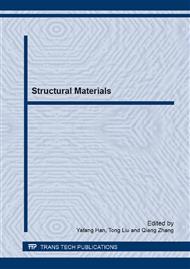p.438
p.446
p.452
p.459
p.466
p.473
p.477
p.483
p.488
Creep Behavior of a Re-Free Nickel-Based Single Crystal Superalloy at High Temperature
Abstract:
The creep behavior of a Re-free single crystal Ni-base superalloy at high temperature has been investigated by means of creep property measurement and microstructure observation. The experimental results show that the creep life of the alloy under the testing condition of 1040 oC/137 MPa was measured to be 556h. In the primary stage of creep, the deformation mechanism of the alloy is dislocations slipping within the γ matrix, and the γ′ phase in the alloy is transformed into the rafted structure along the direction vertical to the stress axis. In the latter stage of creep, the alternate activation of the main/secondary slipping dislocations may twist the rafted γ′ phase to promote the initiation and propagation of the cracks along the interfaces of γ′/γ phases up to the creep fracture. And the various configurations of the rafted γ′ phase appeared in the different regions of the sample, thereinto, the coarsening and twisting of the rafted γ′ phase in the regions near the fracture may be attributed to the bigger plastic deformation.
Info:
Periodical:
Pages:
466-472
Citation:
Online since:
April 2014
Authors:
Price:
Сopyright:
© 2014 Trans Tech Publications Ltd. All Rights Reserved
Share:
Citation:


